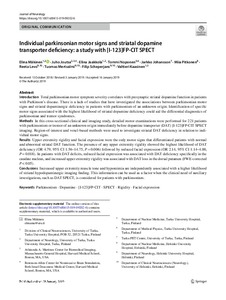Individual parkinsonian motor signs and striatal dopamine transporter deficiency: a study with [I-123]FP-CIT SPECT
Elina Mäkinen; Juho Joutsa; Elina Jaakkola; Tommi Noponen; Jarkko Johansson; Miia Pitkonen; Reeta Levo; Tuomas Mertsalmi; Filip Scheperjans; Valtteri Kaasinen
https://urn.fi/URN:NBN:fi-fe2021042821254
Tiivistelmä
Introduction
Total parkinsonian motor symptom severity correlates with presynaptic striatal dopamine function in patients with Parkinson’s disease. There is a lack of studies that have investigated the associations between parkinsonian motor signs and striatal dopaminergic deficiency in patients with parkinsonism of an unknown origin. Identification of specific motor signs associated with the highest likelihood of striatal dopamine deficiency could aid the differential diagnostics of parkinsonian and tremor syndromes.
Methods
In this cross-sectional clinical and imaging study, detailed motor examinations were performed for 221 patients with parkinsonism or tremor of an unknown origin immediately before dopamine transporter (DAT) [I-123]FP-CIT SPECT imaging. Region-of-interest and voxel-based methods were used to investigate striatal DAT deficiency in relation to individual motor signs.
Results
Upper extremity rigidity and facial expression were the only motor signs that differentiated patients with normal and abnormal striatal DAT function. The presence of any upper extremity rigidity showed the highest likelihood of DAT deficiency (OR 4.79, 95% CI 1.56–14.75, P = 0.006) followed by reduced facial expression (OR 2.14, 95% CI 1.14–4.00, P = 0.018). In patients with DAT deficits, reduced facial expression was associated with DAT deficiency specifically in the caudate nucleus, and increased upper extremity rigidity was associated with DAT loss in the dorsal putamen (FWE-corrected P < 0.05).
Conclusions
Increased upper extremity muscle tone and hypomimia are independently associated with a higher likelihood of striatal hypodopaminergic imaging finding. This information can be used as a factor when the clinical need of auxiliary investigations, such as DAT SPECT, is considered for patients with parkinsonism.
Kokoelmat
- Rinnakkaistallenteet [27094]
